|
|
| |
|
|
| |
| Collieston
is the only village in the farming parish of Slains.
Traditionally there was very little interaction
between the fisherfolk and their farming neighbours.
To a lesser extent this still remains the case at the
start of the 21st Century. |
|
| |
| |
|
|
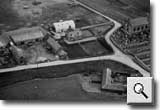 |
| Kirkton
Farm |
| |
Kirkton
Farm and Farm Buildings in 1964. Built of stone, with
a slate roof, the farmhouse comprises the following
accommodation: - Two sitting rooms, a kitchen, scullery
and milk room, four bedrooms, two boxrooms and a bathroom.
Situated a short distance away are the farm buildings
comprising a covered cattle court, two cow byres, two
barns, a root house, food store and loft, two deep litter
chicken houses and an old bothy, now used for general
storage purposes.
To the right of Kirkton Farm, Slains Parish Church is
clearly visible as is the Glebe, the L-shaped building
in the foreground.
|
| |
|
|
| |
|
|
| |
A
red granite stachle stane |
|
| |
| |
Stachle
Stanes were used as the bases to support the wooden
frames that haystacks were built on roughly half a metre
off the ground. Typically 6 or 8 stones would have been
set up in circles up to some 6 metres in diameter. The
purpose in building hay stacks this height above the
ground was to help speed up the drying process. The
mushroom like top section of the stachle stane formed
a lip that prevented rats from getting into and spoiling
the hay. This particular stachle stane was once used
at the Collieston Church Glebe.
|
|
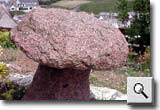 |
| |
|
|
| |
A
horse and cart on the farm of Smiddyhill in Slains Parish
near Collieston |
|
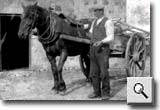 |
The
cart is fitted with a wooden frame, possibly to help
contain a load of hay.
|
| |
|
|
| |
|
|
| |
Draught
horses on the farm of Smiddyhill in Slains Parish near Collieston
|
|
| |
| |
The
horses are unharnessed, behind them is one of the Smiddyhill
farm buildings – downstairs is the chaumer or
bothy where the umarried fee’d farm servants would
have lived. Above is the hay loft door that would have
been accessed by ladder and provided storage for hay
or bags of grain.
To the left of the horses, a young man is standing holding
a baby – given that few farm servants could afford
to marry until they were much older, this is likely
to be the farmer’s son and a member of the Esson
family.
|
|
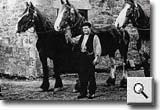 |
| |
|
|
| |
Sheep
shearing at Smiddyhill farm in Slains near Collieston |
|
 |
Three
men are shearing using hand shears. The men are working
in the shearing and dipping area of the farm.
Wool has always been an important part of Aberdeenshire’s
rural economy. For well over 100 years sheep have
been reared in Slains both for their wool and for
succulent lamb meat.
Originally the wool would have been sold to the numerous
mills in Aberdeen. These included the famous Grandholm
Mill that was the original manufacturer of the famous
Crombie cloth that once clothed senior operatives of
the USSR’s KGB.
|
| |
|
|
| |
|
|
| |
Haymaking
on Smiddyhill Farm in Slains near Collieston |
|
| |
| |
Three
haymakers pose for the camera.
Two men are standing in front of the cart ready to
fork up hay to a man standing on top of hay that has
already been loaded on to the cart.
Stooks of grain (most probably oats or barley) are visible
in the background, indicating that the hay being forked
onto the cart may already have been threshed and in
which case may be straw not hay – hay being fodder
for the winter and cut from grass fields, whilst straw
provided winter bedding for cattle and was the stalks
left over after the oats or barley had been threshed.
|
|
 |
| |
|
|
| |
Aerial
View |
|
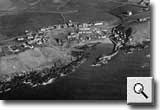 |
| |
A general
view of Slains Estate in 1964 when it was sold by Sir
Ian Walker-Okeover to Sir Richard Sutton Settled Estates.
The Estate has a 5-mile frontage to the East Coast of
Scotland, immediately north of Newburgh and bounded
by the River Ythan Estuary on its southwest side.
Comprising Forty-seven Mixed Farms ranging from 934
Acres to 5 Acres, the Estate also boasts Moorlands,
Lochs and Foreshore totalling 1,865 Acres, 6 Cottages
and the Sporting Rights over the whole Estate.
Many of the properties in Collieston, clearly visible
in the foreground above the coastline, are privately
owned but are required to pay Feu Duties to the Estate
in respect of small pieces of land sold in past years.
Some of the properties are still owned by the Estate
and rents, in respect of tenancies, are required to
be paid to the Estate.
|
| |
|
|
| |
|
|
| |
Slains
Estate is put up for sale |
|
| |
| |
| In
1964 Slains Estate was offered for sale by auction.
This
bill of sale provides a detailed account of
all the farms and small holdings that made up the
estate at the time.
|
| |
|
 |
| |
|
|
| |
Aerial
View |
|
 |
| |
A general
view of Slains Estate in 1964 when it was sold by Sir
Ian Walker-Okeover to Sir Richard Sutton Settled Estates.
The Estate has a 5-mile frontage to the East Coast of
Scotland, immediately north of Newburgh and bounded
by the River Ythan Estuary on its southwest side.
Comprising Forty-seven Mixed Farms ranging from 934
Acres to 5 Acres, the Estate also boasts Moorlands,
Lochs and Foreshore totalling 1,865 Acres, 6 Cottages
and the Sporting Rights over the whole Estate.
Many of the properties in Collieston, clearly visible
in the foreground above the coastline, are privately
owned but are required to pay Feu Duties to the Estate
in respect of small pieces of land sold in past years.
Some of the properties are still owned by the Estate
and rents, in respect of tenancies, are required to
be paid to the Estate.
|
| |
|
|
| |
|
|
| |
Milton
of Colliestom Farm |
|
| |
| |
| The
Fyvie Family, who farmed at Milton of Collieston Farm,
circa 1910. As the name suggests, there was a mill
on the farm, in addition to a substantial number of
horses.
The family, here represented by at least three generations,
all of whom are very smartly attired, would have had
several employees (fee’d farm servants) working
for them both in the farmhouse and on the farm itself.
To the rear of the family, horses are pulling a plough,
with a watchful eye being kept on them by the horseman.
|
| |
|
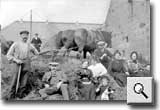 |
| |
|
|
| |
Slains
Estate Bill of Sale |
|
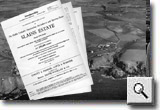 |
| |
| Bill of
Sale of Slains Estate in 1964. Slains Estate, for sale
by auction at The Station Hotel, Aberdeen on Thursday
16th July, 1964 at 3 p.m. by direction of Sir Ian Walker-Okeover,
Bt., covered approximately 7,574 acres and consisted
of forty-seven beef, sheep and arable farms, ranging
from 934 acres to 5 acres, and five cottages.
Included in the sale were the Sands of Forvie and
Foreshore, Lochlundie Moss, Sand Loch, Cotehill Loch,
Meikle Loch and Little Loch.
In addition to providing photographs of a general
view of the Estate along with several of the farms
and lochs, the Bill of Sale document gave detailed
information about each Holding, of which there were
fifty-eight in total.
|
| |
|
|
|
|
|
|
|
|
|
copyright
collieston's century 2003 |
|